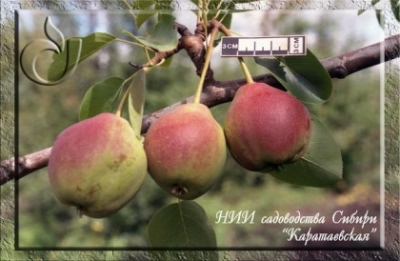
- Authors: Puchkin I.A., Kalinina I.P., Karataeva E.P. (Federal State Budgetary Scientific Institution Federal Altai Scientific Center of Agrobiotechnology)
- Appeared when crossing: from pollination of the Vnuchka variety with the pollen of the Dessertnaya Mlievskaya variety
- Year of approval: 2011
- Fruit weight, g: 107
- Ripening terms: early autumn
- Fruit picking time: from mid-September
- Appointment: universal
- Growth type: medium height
- Marketability: good
- Height, m: 2-4
Pear Karataevskaya can be an excellent filling for any garden. However, it must be grown very carefully and carefully. Therefore, you will have to study the specific circumstances and characteristics.
Breeding history
The honor of developing this plant belongs to the employees of the Altai Scientific Center of Agrobiotechnology. The main work was supervised by the breeders Puchkov. Kalinin and Karataeva. The process consisted in the use of Dessertnaya Mliyevskaya pollen for pollination of pear trees Granddaughter. It is known that the state registration of the plant took place in 2011.
Description of the variety
Medium-sized trees of Karataevskaya reach 2-4 m in height. The crown has a rounded shape. Branches typically have a sparse arrangement. Thick shoots are colored in a light brown tone, the tops are pubescent. Other features:
weak leafiness of trees;
the average size of the leaves, which are ovoid and dark green in color;
the formation of fruits on simple or complex ringlets.
Fruit characteristics
On average, the fruits weigh 107 g. Their shape is like that of a classic wide pear. The skin is not too coarse, but it is glossy and oily. The subcutaneous points are numerous and visually noticeable. The fruits are colored green, under normal conditions they are stored for up to 14 days, in refrigerators for up to 60 days. In the period of consumer maturity, the main color is whitish, the integumentary color is blurred, dark red.
Taste qualities
The white flesh is moderately firm. It has a sweet and sour taste. The fruits are also very juicy. The proportion of sugars reaches 12.2%, and the concentration of titratable acids is 0.64%. For every 0.1 kg of dry weight, there are 62 mg of tannins.
Ripening and fruiting
Karataevskaya pear is a typical early autumn variety. Harvesting begins in mid-September. The first fruiting begins at the 4th or 5th year of development. It is almost impossible to predict this in advance. In the future, new pears will appear every year. Exceptions are associated only with completely nasty conditions of detention and with violation of the rules of care.

Yield
The productivity of the Karataevskaya pear is officially declared at the level of 16.7 kg of fruits from 1 tree. The harvest from 1 hectare can reach approximately 114 centners. According to other sources, it is at the level of 9.3 tons. The conditions of detention and how well the weather develops play an important role. It is also worth emphasizing that the harvest is of high commercial quality.
Growing regions
Pear Karataevskaya was zoned for Eastern Siberia. Therefore, its landing in regions with a milder climate is theoretically possible. But in practice, objective information is very lacking for this.It is necessary to pay attention to the average drought resistance of this variety. In places with little rainfall, increased watering will be required.
Landing
This variety is extremely susceptible to weather fluctuations. For him, you will have to choose areas that are well lit, sheltered from the wind. The southern and southeastern sides are best suited, provided that there are no drafts. The distance to any other tree should be 4-7 m. The optimal soil is a combination of sand and clay; you can also apply brown and gray forest soil.
The substrate must be moistened. After loosening, peat is laid in it. It is better to prepare holes in the fall. The optimal time for planting is the beginning of weather spring. If you prefer an autumn landing, you need to prepare the pits in about 20-25 days. It is also useful to saturate the holes with manure.


Growing and care
In the first year, Karataevskaya must be watered intensively, using 20-30 liters of water at least 4 times during the growing season. Even more often, this should be done during dry periods. Mature trees can be watered 2 times per season. Sprinkling will be optimal. At the beginning of the second year, you should whitewash the trunks and fertilize the soil. Additionally, you will need to trim the pear and form the crown.
In the first year, the tree is pinched. This is important for activating shoot growth. For the next years, they resort to full-fledged pruning. It is imperative to eliminate single overgrowing replacement branches. Due to the low frost resistance, measures must be taken with the approach of winter.
We are talking about:
covering the near-trunk area with mulch (thicker);
wind protection;
snow retention;
wrapping of the trunk and bottom of skeletal branches in young pears;
water charging irrigation.




Like any other fruit trees, the pear needs protection from various diseases and pests. When planting a pear on your site, you need to know in advance what diseases you should beware of. To successfully carry out the struggle, it is necessary first to correctly identify the cause of the problem. It is important to distinguish signs of disease from manifestations of the presence of insects, mites, caterpillars and other types of pests.
Review overview
Quite a few farmers appreciate the karataevskaya pear. Despite the small size of the fruits, they have excellent gastronomic characteristics.However, the disadvantage is the low resistance to winter, which is also often noted. In general, positive reviews dominate. Much depends, as always, on the breeders themselves.





































































